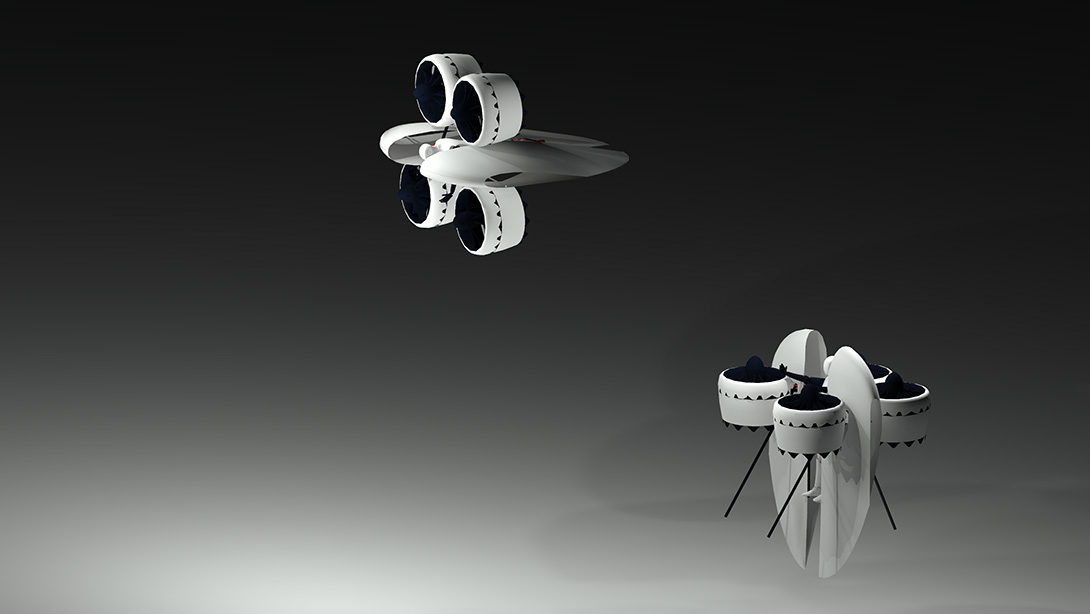Georgian drone startup looks to spread its wings come summer

Georgia’s lone drone startup Raven began its ascent to the skies after founder Irakli Shengelia set off down a black diamond ski slope at the country’s most popular ski destination of Gudauri, with families huddled below in anticipation of whether he’d eat ice or glide off the ground with the help of a pair of inflatable wings.
Three years later and soaring, Raven is looking not just to entertain crowds in Georgia’s ski resorts craving a dose of schadenfreude, but to revolutionize the field, which Drone Industry Insights predicts will reach a $43 billion market value by 2024. Further down the line, Morgan Stanley predicts a drone market with a possible value of $1.5 trillion by 2040.
The industry is still fluttering, trying to decide what makes and models will get the job done. Shengelia and his team have settled on a vertical take-off and landing (VTOL in industry-speak) approach, which they believe has the potential to radically alter both public and private transportation.
“VTOL has numerous implications for transport, consumption, urban design and ecology: aircraft that can take off and land theoretically anywhere with a flat, stable surface are much more flexible in their application than traditional aircraft, and they can perform maneuvers not possible with a conventional plane.”
But the days of personal transport vehicles dotting the skies are still a decade or two away. There are numerous technologies to be mastered, aero-fields to be built and fly-zones to be carved out above buzzing, already congested metropolises.
“In the meantime,” Shengelia says, “there are other horizons to be explored to help us get there.”
Raven has turned its energies to agriculture, which stands to benefit greatly from the introduction of drones.
“I’m very much a fan of smart agriculture and organic farming. Drones with maneuvering capabilities/autonomy such as ours and that can deliver high payloads of agrochemicals and fertilizers will have much to offer. They can also carry out livestock and field monitoring, and are used in large scale reforestation missions to tackle climate change, oversee irrigation processes and help farmers analyze their fields and find areas in need of intervention. This helps farmers avoid the overuse of certain products, and saves time and resources. Cameras used in the process can identify even a single pest,” Shengelia notes.
Multispectral imaging, Irakli says, “are like MRIs for plants”: they offer the promise of being able to identify plants lacking nutrients, plants under attack from pests, and other stresses.
The concept would be welcome in Georgia, which has recently been struggling with agricultural pests in the country’s western regions, but ultimately Raven has its eyes on the global market.

“Georgia is a good market for a startup like ours; hazelnuts, vineyards and high-value crops in general would be in need of such an innovation. We are hoping to already begin operations with our drones later this spring, offering crop multispectral analysis, spray works and fertilizer application. This will generate our first revenue stream and extend our runway. Of course, we will be seeking seed investment to be able to form a good world-class team for fast and aggressive scaling. We already have some momentum and interest from various parties that are interested in both agricultural and personal flying devices. We also hope that as soon as we mature for seed investment, we will be able to get a matching 650,000 GEL grant from GITA, as have done other promising startups in Georgia,” Shengelia says.
As for personal flying devices, Shengelia’s dreams have not been put off indefinitely:
“Much of it comes down to safe flight hours. This is one of the motivations in our decision to begin with agriculture; you need to demonstrate that your apparatus can safely be operated for thousands of hours on end. That’s why we’ve put our bet on agriculture, which requires precision, and long hours in the field.”
When personal flying devices do appear, there will be no need to fear clogged skies and the constant whir of drones, Shengelia notes.
Before the technology matures, personal drone travel is more likely to start with suburban transit, he says, where safe airways and relatively more open space will be much more forgiving in case of mistakes and unexpected aircraft behavior. Just like traditional fixed-wing aircraft, safe landings are provided for by fields, not urban environments. Raven, its creator says, will most likely enter the market as an adventure/recreational personal aerial vehicle and later aim to become a shared transport means just like electric scooters.
Only following a gradual introduction would drones begin to penetrate cities, Shengelia says, which would evolve to incorporate municipal airways, keeping drone traffic out of large swaths of cityscape.
And owls have a piece of good news for the sensitive ear. “Some very promising research and prototypes in modern propeller designs mimic the snowy owl’s wing structure for silent flight. The same concept is utilized to kill the sound of spinning propellers that produce around 80% of a vehicle’s noise, something the industry is very much dedicated to and which promises significantly lower noise levels,” Shengelia adds.
At any rate, we have several years before we have to start worrying about these issues. But when the time does come about, if you’re in Georgia, keep your eye to the sky — one of the first flyers you’ll see might just be a Raven…
____________________________ ADVERTISEMENT ____________________________


